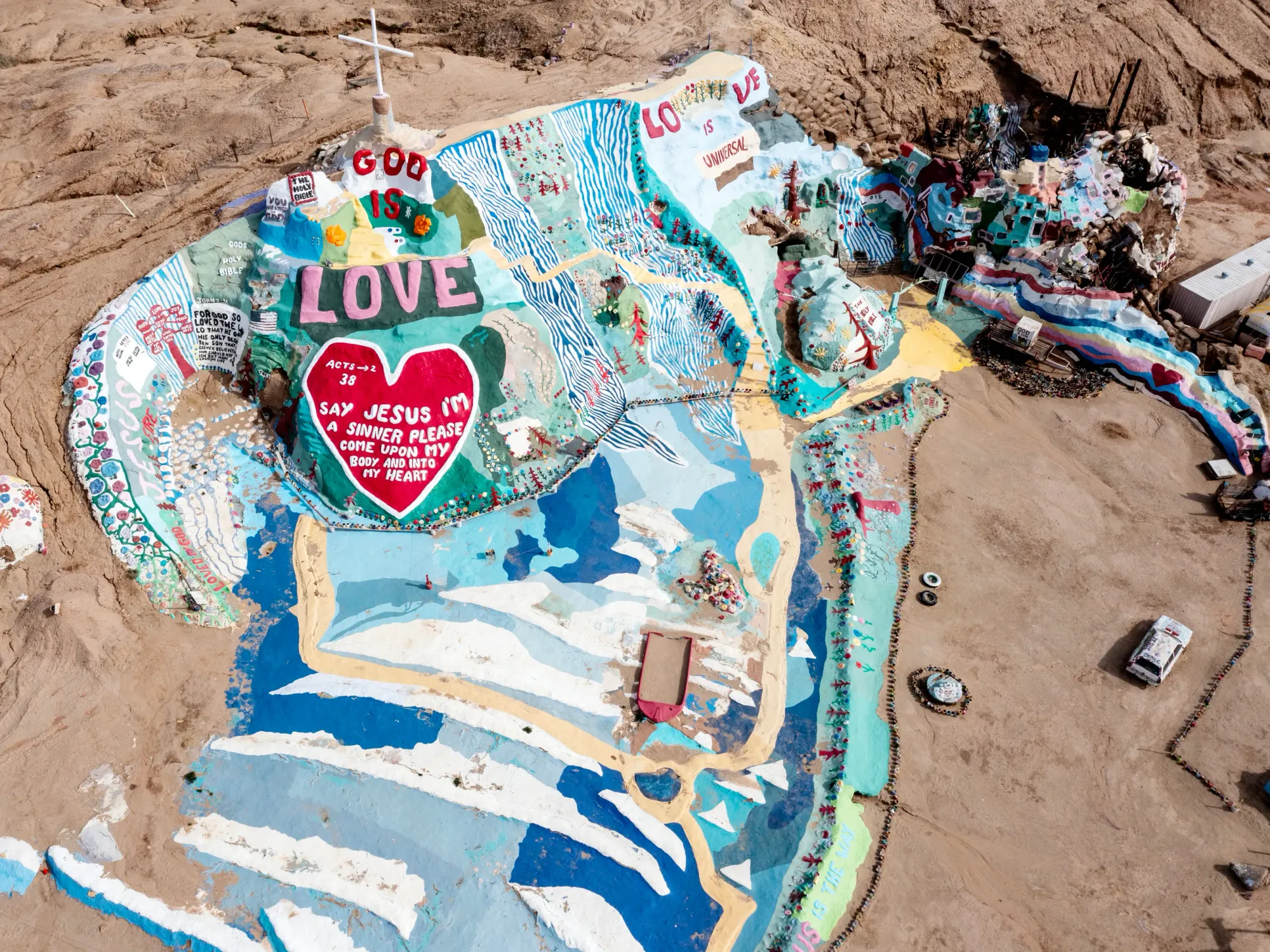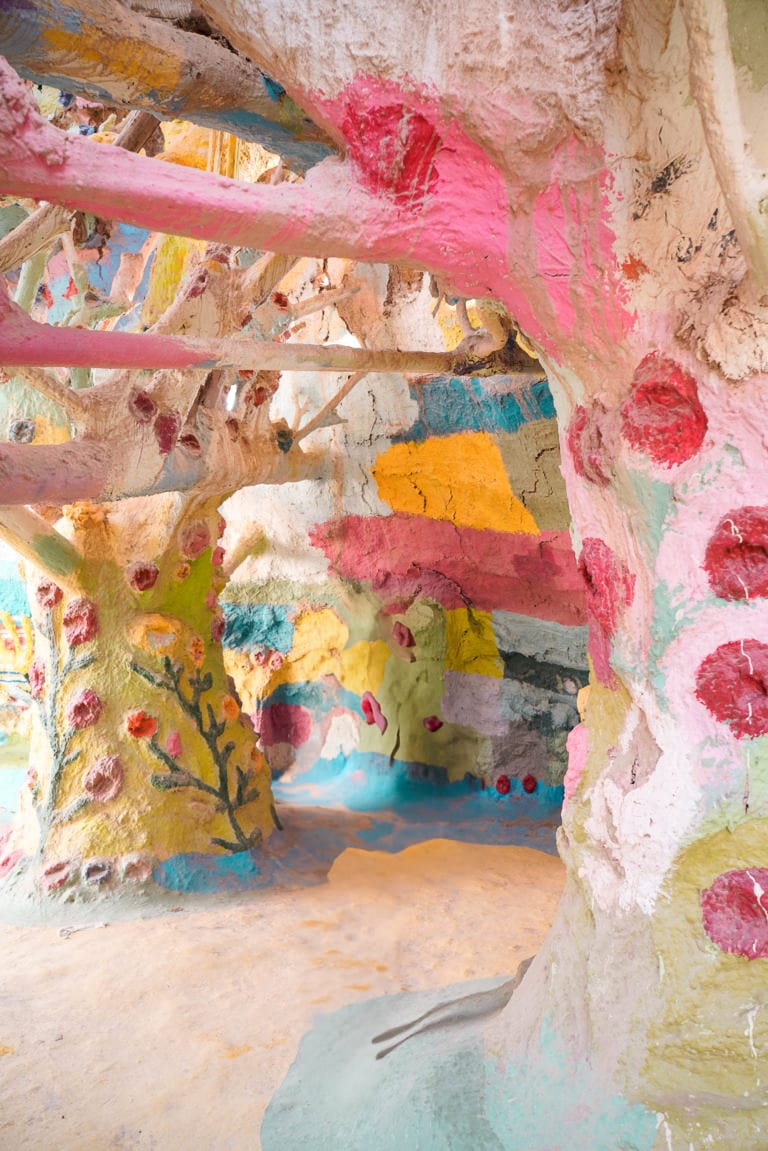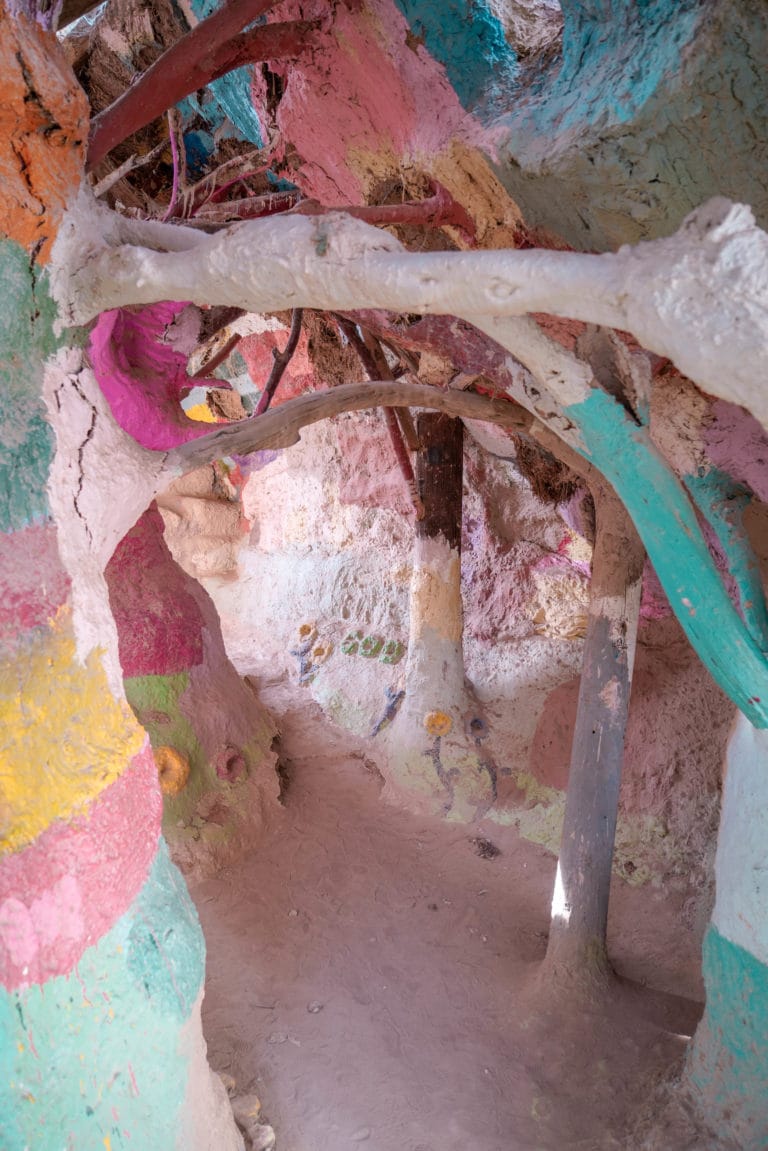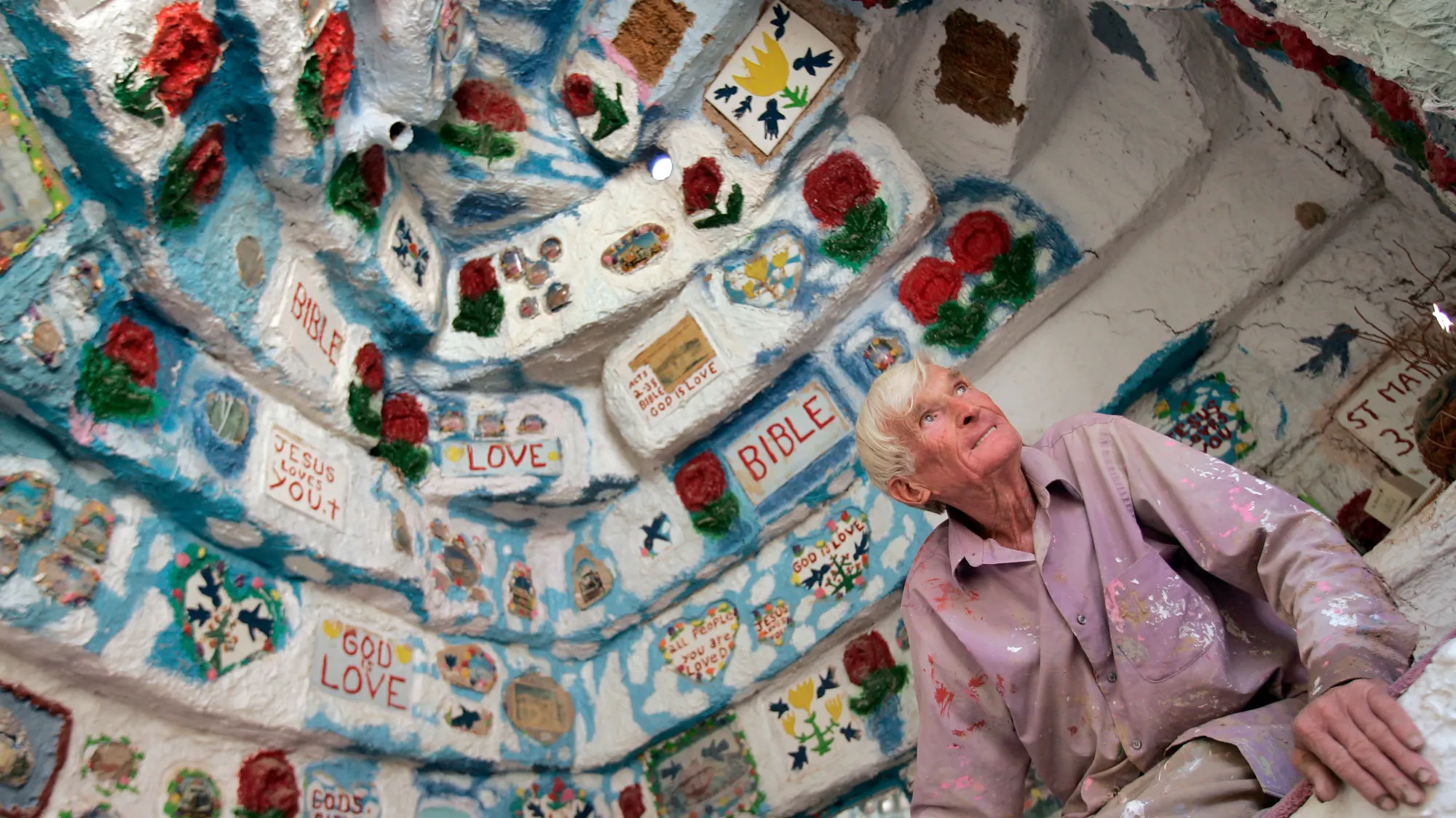Leonard Knight's story begins not with triumph, but with failure.
Knight spent years sewing a giant hot air balloon stitched with the words God is Love. His hope: to float the message across the sky, a drifting cathedral of fabric and faith. But the seams rotted in the desert sun, the balloon crumpled, and the dream fell.
Undeterred, he turned to earth.
In 1984, in the dust outside Niland, California, he began building a mountain—an adobe monument layered with paint, straw, and conviction. The first version rose quickly, a 50-foot heap of sand and cement. But rain came. The foundation cracked. The entire structure began to collapse. Anyone else might have quit.
Knight started again.
This time, he mixed adobe clay with straw, applied paint after paint until the surface hardened, until color itself became a kind of mortar. He scavenged telephone poles, tires, car parts. Donations of leftover house paint arrived by the bucketload. Over nearly three decades, he poured more than half a million gallons of paint into the desert, layering the slope with technicolor rivers, biblical verses, flowers, suns, trees. At its peak: three stories high, 100 feet wide, shimmering under the California sky. He called it Salvation Mountain.

And all of it—unpaid.
Living otherwise
Most people spend 28 years building careers, collecting titles, repaying mortgages, and accumulating savings. Leonard Knight spent 28 years painting a mountain.
Meaning, for him, was not fortune, achievement, efficiency, or remuneration. Meaning was devotion—a long fidelity to a vision that kept collapsing, kept demanding to be begun again.
This is what it means to live otherwise. Not simply to quit a job or move abroad. Not simply to leave the office for a laptop in a café. But to step outside the gravitational field of 21st-century globalized corporate capitalism—where every choice is shaped by efficiency, productivity, scalability, optimization. To live otherwise is to refuse that script.


And refusal is not abstract. It is material, embodied. Knight lived out of his painted truck. He had no electricity, no running water, no paycheck. What he had was a brush in his hand and a conviction in his body that this was what life was for.
Devotion across worlds
There are many ways of living in the world.
In Thailand, monks rise each dawn to sweep temple paths, their labor dissolving with the next wind, only to be repeated tomorrow.
But devotion does not always wear spiritual robes. It can be secular, scientific, ecological, artistic.
In France, Claude and Lydia Bourguignon spent decades defending living soil, studying earth microbes when industrial agriculture dismissed them as irrelevant. Their fidelity to soil ecology reshaped farming across Europe.
In California, Judy Baca has been painting The Great Wall of Los Angeles since 1976, a half-mile-long mural that has stretched over 40 years, with each season’s return adding new panels, new voices, new colors.
In Nigeria, El Anatsui’s shimmering tapestries, woven from discarded bottle caps, have spanned decades, a practice of patiently assembling thousands of fragments into monumental works that travel the world.
In England, volunteers at Knepp Estate committed to a 25-year rewilding project, refusing short-term metrics of “productivity” and instead waiting decades to watch nightingales return and rare butterflies reappear.
In Chile, astronomers devote whole lifetimes to observing one patch of sky, their names attached not to profits but to the patient cataloging of stars. For some, 30 years pass tracking a single system.
These, too, are devotions. They are not profitable in the sense modern economies demand. They rarely produce wealth. They do not offer “career trajectories.” What they do is mark time differently—in rhythms of repetition, in rituals of attention, in fidelity to a craft, a land, a body of knowledge, or a community that outlives individual ambition.
Knight’s mountain belongs in this lineage: not an eccentric outsider art project, but a global expression of a deeper human capacity—to give one’s life to something simply because it matters.
The nomad script
Digital nomadism often markets itself as a radical break from the default. Not cubicles, but coworking in Bali. Not nine-to-five, but “freedom” on the road. Not suburban mortgages, but Airbnb lofts and coliving hubs.
But we need to name what is obvious: digital nomadism has its own script. Chiang Mai. Lisbon. Medellín. Laptops in cafés, flat whites, and surfing between Slack calls. It feels different because the scenery has changed. But as J.D. Salinger wrote in Franny and Zooey:
“And the worst part is, if you go bohemian or something crazy like that, you’re conforming just as much as everybody else, only in a different way.”
This is the paradox of digital nomad life. It presents itself as originality, but often becomes another conformity: a different way of doing the same thing.
What makes Leonard Knight’s life stand apart is not just that it was unusual—but that it was truly original. He wasn’t rejecting one path only to follow another subcultural pattern. He wasn’t swapping the office for the café, the mortgage for the Airbnb. He was giving himself, day after day, to something no one else would have thought to do. Twenty-eight years painting a mountain is devotion in its most unrepeatable form—a life project that could only have been his.
Devotion at scale
Devotion at that scale is almost inconceivable in modern life.
Twenty-eight years. Nearly three decades of waking up, mixing adobe, slapping on paint, watching the desert sun crack the surface, and returning the next day anyway.
We are taught to think in quarters. In annual reviews. In election cycles. In the lifespan of technologies that turn obsolete within five years. Our culture has trained us to measure meaning in metrics that reset every fiscal year.

Knight’s mountain defies this. It says: life is not measured by speed, efficiency, or visibility. It is measured by what you will keep returning to, even when it collapses, even when no one pays you, even when no one is watching.
Beyond belief
You do not need to share Leonard Knight’s religious views to take something from his story. His mountain was devoted to his vision of God’s love, yes, but the lesson transcends belief.
The mountain is less about theology than it is about fidelity. About the willingness to live, year after year, for a project that earned him nothing but the satisfaction of simply doing it.
Religion gave him his vocabulary, but devotion (perhaps the physical manifestation of conviction) gave him his monument.
Toward an ontology of original life
Salvation Mountain invites us to consider not simply the category of “devotion,” but the conditions of originality itself. What does it mean to enact a life that is not a replication of inherited scripts—careerism, productivity, even countercultural subcultures—but instead one’s own ontological project?
Philosophers of existentialism would call this authenticity, though authenticity has too often been co-opted into aesthetic branding. What Leonard Knight demonstrates is closer to what we might call ontological singularity: a form of life that becomes irreducible to external categories of value. His mountain is not a job, not a hobby, and not a movement. It is an objectification of a life-purpose that can only be understood in its own terms.
Here we are pressed to ask: is originality even possible under conditions of globalized capitalism, where even difference is swiftly commodified?
Digital nomadism, for instance, too often presents itself as a form of original living, yet it too crystallizes into reproducible patterns.
Knight’s project resists this by never being replicable. You cannot “scale” Salvation Mountain. You cannot package it into a course or a lifestyle brand. It remains what philosopher Giorgio Agamben might call an inoperable form of life—a life that resists instrumentalization.
The rigor here is in noticing that originality is not simply doing something unusual. It is inhabiting a purpose so singular that it escapes categorization. To borrow from Hannah Arendt, Knight’s labor becomes “action”: not mere work for survival, nor labor for reproduction, but a deed that inaugurates something new into the world. The philosophical force of Salvation Mountain lies not in its religiosity, but in its ontological exceptionality: it exists as a reminder that a human life can become untranslatable into any system of value except its own fidelity.
Containers for living otherwise
What makes Salvation Mountain resonate is not that it is eccentric, but that it belongs in the lineage of the great life projects: works like Moby Dick or Gaudí’s Sagrada Família, visions carried with a stubborn fidelity until they transcend their maker and become part of the cultural commons. Knight’s mountain is smaller, humbler, patched with leftover paint rather than marble or cathedral stone. Yet its greatness lies in that same refusal of ordinary time—a life stretched around a single, improbable task until it could no longer be ignored.
Why does this matter for us, here, now? Because it shows that it is still possible to live according to a rhythm unrecognizable to the dominant scripts of accumulation and optimization. Yes, most of us must labor to sustain ourselves. Yes, privilege shapes who can afford to give decades to a vision. But even within those constraints, the provocation remains: what would it mean to give your life—or even your evenings, your seasons, your spare hours—to a practice that is not reducible to career or consumption, but that opens onto another way of living?
To celebrate Knight only as eccentric or unique is to miss the point, and to commend originality for originality’s sake. The value of his originality is not that it produced something unprecedented, but rather that it created a container—a lived form, a rhythm of practice—that could exist outside the mediation of the global economy. This is what makes the mountain remarkable. Originality, in this sense, becomes less about "being different" and more about making possible a way of living on entirely other terms. To glimpse Salvation Mountain is to glimpse possibility: that even now, in the most commodified of centuries, human life can still be organized around practices that resist capture.





